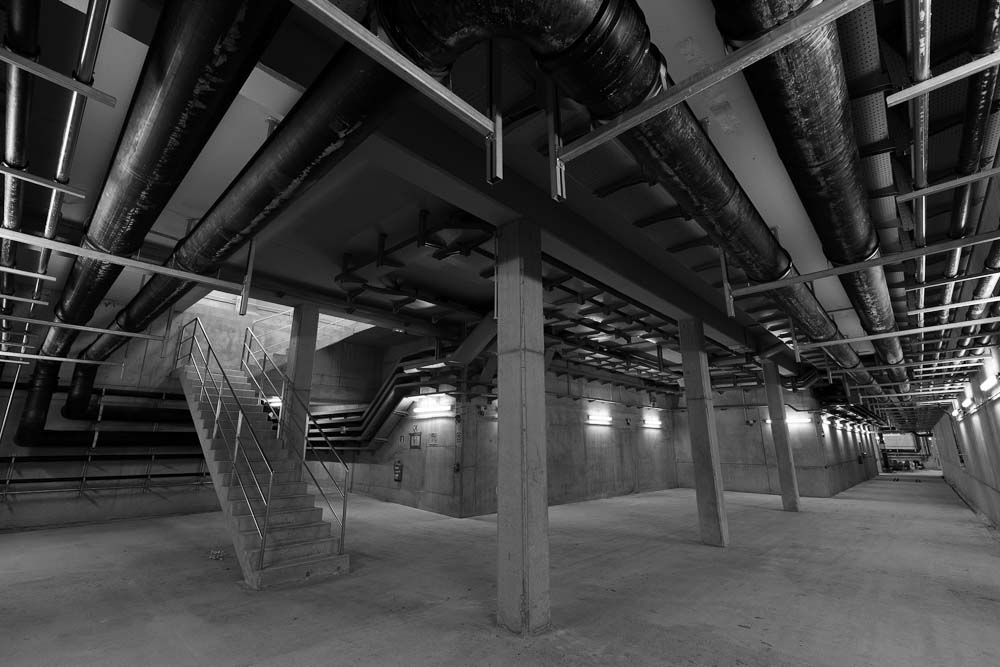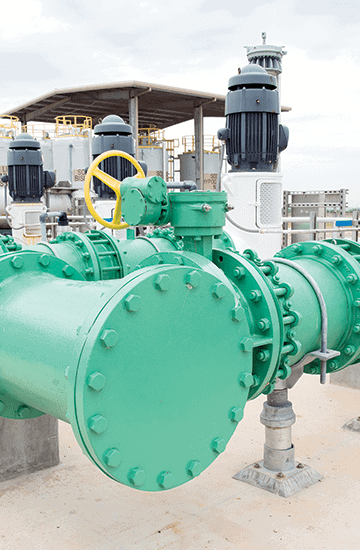

A Coruña, España
-
2M
m³ of land
-
60000m²
expansive
-
Residents
600000equivalents (capacity)
-
Recovery
950kWin 2 engines
The Bens WWTP, designed for a population of 600,000 inhabitants, is undoubtedly an iconic project due to its technology and its complex location. Making a model of the terrain with its over two million cubic meters of soil was necessary for this project.
In 1997, the “Improvement to A Coruña’s purification and discharge” construction work was declared to be of general interest to the State (Law 22/1997). The objective was to provide the municipalities of A Coruña, Arteixo, Cambre, Culleredo, and Oleiros with an actual purification system that treated wastewater with a guarantee, allowing it to meet the demands of the European Union’s guidelines on water quality. In this situation, the Bens WWTP was awarded to the UTE composed of Ferrovial Agromán, S.A. and Cadagua, S.A.in June 2004. Technical assistance to managing the construction was handled by Noega Ingenieros, S.L. and Vaico Ingenieros Consultores, S.A.
The new Bens WWTP was designed to serve a future population equaling 600,000 inhabitants, with the ability to treat a maximum flow of 6.7 m³/s of wastewater. The infrastructure also has a UV disinfection system and an underwater outfall that makes it possible to dilute the water treated at sea over 900 m from the coast. As such, it is in compliance with the European guidelines on purification/sanitation, water quality for raising mollusks, water to be used in bathrooms, and sludge treatment for purification.
Construction on this infrastructure – which occupies an expanse of nearly 60,000 m² located between the southwest slope of the Monte Alberto and the seaboard, between the inlet at Bens and Redonda Island – has meant significant work in moving earth. They had to make a model of the terrain over two million cubic meters, an area which is also undergoing preparation for the “Paseo marítimo,” A Coruña’s metropolitan boardwalk, which will reach 30 m above sea level – and the new WWTP.
The raw water begins treatment at the screen chamber, which has two trituration channels at its end equipped with grates and two submergible channel crushers. After them, the water flows into the pumping well for raw water, composed of 7 centrifugal submergible pumps. Then, there is a fine grinder with five channels equipped with automatic 3 mm sieves, eight desander-defatters aerated with a spiral flow that concludes the pretreatment process.
The complex terrain required a compact design and an array of technologies with a small footprint, such as the ten primary decanters with lamellar clarifiers and square shapes, or the six secondary rectangular decanters with suction and flat bases. The biological reactor is complete with 3 pools, each with an approximate volume of 9,150 m³, and it is composed of a facultative selector (7%), a facultative area (16%), an oxic zone (77%), and a deaeration chamber.
After the purified water is disinfected, the treated water goes to the loading chamber of the underwater outfall through an underground pipe made of FRP with a 2,350 mm diameter. The loading chamber has an 11 m diameter and is 18 m deep, and the outfall, designed for a maximum outflow of 6.7 m³/h, is 920 m long, with an underground section measuring 560 m and a section of underwater outfall that is 360 m.
Sludge thickening is done with 5 thickening cells with a unit capacity of 100 m³/h. The thickened, conditioned sludge goes on to the corresponding anaerobic digesters measuring 28 m in diameter and 21 m total in height, which entails a unit volume of 11,000 m³. As such, for this phase the holding time is 21.4 days, and for the future phase it is 20 days. It is important to highlight that, due to environmental impact, the digesters have been partially buried (7.6 m) around their cylindrical part.
The agitation and warming system for the sludge used in this project is the Heatamix® system, technology that was developed and registered by Cadagua. The Heatamix® systems are mixed agitation and warming systems located outside of the digester that agitate the sludge mass using an air-lift effect, caused by injecting pressurized gas into the inner tube while hot water circulates in the jacket.
After digestion and subsequent dehydration by means of 3 centrifuges measuring 30 m³/h each, the sludge goes on to the final Thermal Drying process. This system is based on the process of turbo-desiccation and ensures final dryness of 85%.
During the digestion process, a biogas is produced that is stored in a gasometer for subsequent energetic use. Energy recovery is achieved by means of two 950 kW electric motors. What makes these engines unique is that they can be used as a generating set in case of an electrical outage at the WWTP, which made it necessary to install an additional natural gas rail. The residual heat from water from the jackets and the drip gases from the motor generators are used for warming the sludge in digestion.
Given the plant’s dimensions, two installations were included for eliminating different odors: one for the area where raw water is pumped (the raw water pumping building + the old pretreatment building) and another that serves the sludge area and new pretreatment (the bar screen building + the sludge treatment and energy recovery building). These installations cleanse the air of odors at a rate of 36,864 m³/h and 77,710 m³/h, respectively.
EDAR DE BENS
Related projects
See more projects
Hamby Wastewater Treatment Plant

